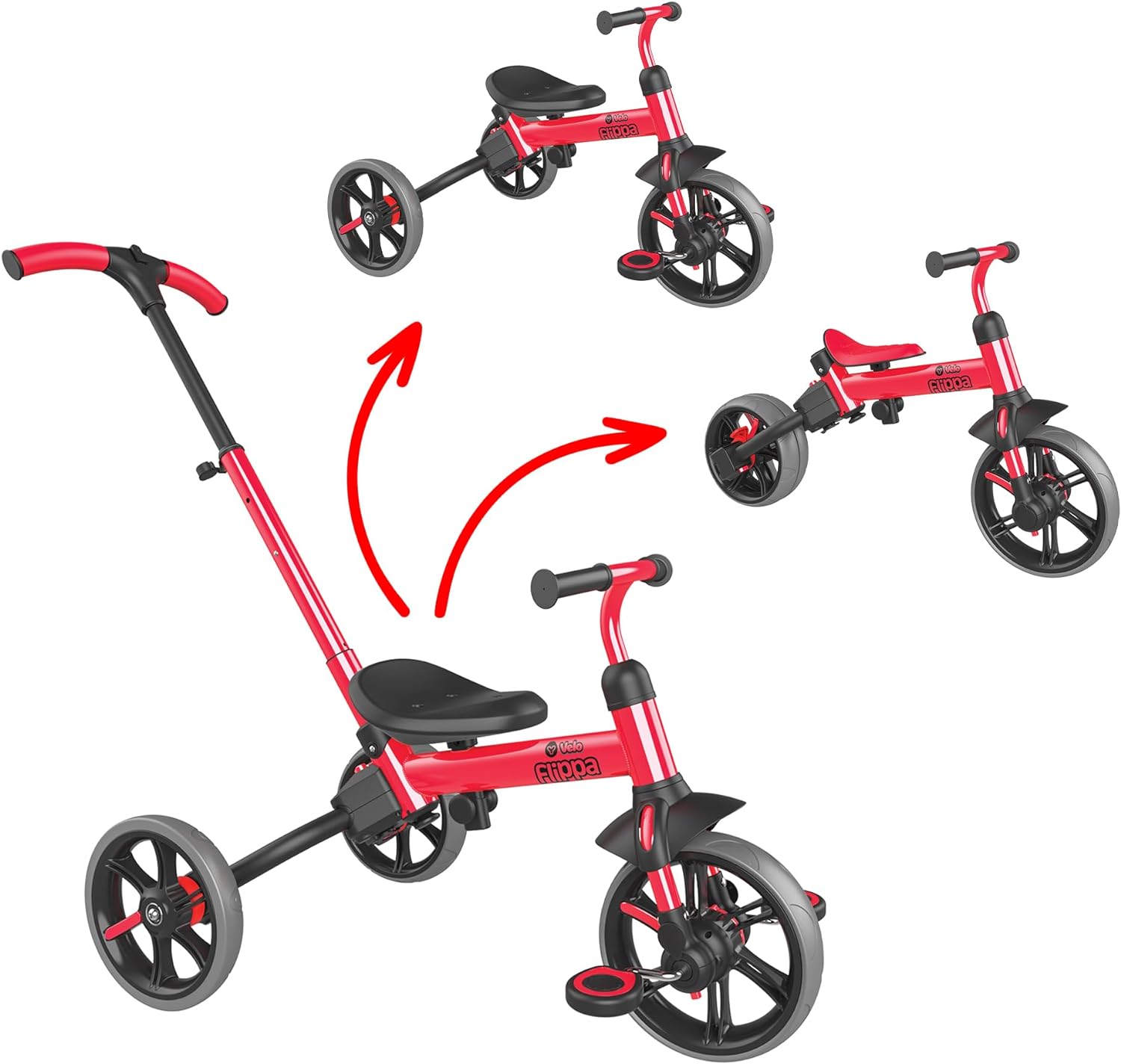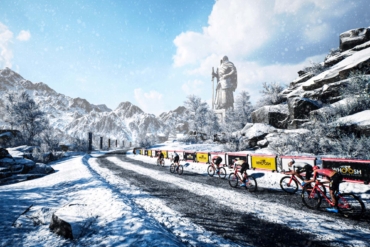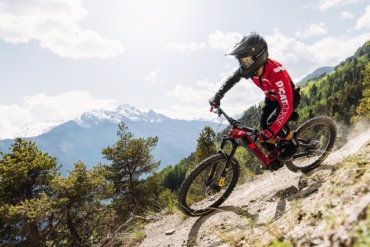Before tackling a mountain bike trail’s curves and more aggressive terrain, we all started with the basics of learning how to ride a bike. These best kids’ balance bikes — also called glider bikes or strider bikes — help a wide range of kids quickly learn to ride safely and confidently.
Choosing the right balance bike for your child takes some time. You’ll need to make decisions between air tires or foam tires, aluminum frame or steel, hand brakes or fully free, and the list goes on. Fortunately, we’ve done a lot of the legwork for you and found the right balance bikes for kids of all sizes and abilities on the list.
Scroll and look around, and check out the bikes we ranked. Also cruise straight down to the Buyer’s Guide and Price & Value section to help the big decisions feel a bit easier, and check out our Comparison Chart for some detailed specs.
Balance bikes are the next big move in teaching kids to ride a bike, but there’s a lot more to it than just buying the bike. After picking out the bike, check out our article on How to Teach a Kid to Ride a Bike to learn how to teach your child to use a balance bike.
Editor’s Note: We updated this guide on November 13, 2024, with the addition of a Price & Value section to aid in your decision-making process.
The Best Balance Bikes of 2025
- Best Overall Balance Bike: Woom Original 1
- Best Budget Balance Bike: Chillafish Charlie
- Best Low-Maintenance Balance Bike: Strider 12 Sport
- Most Versatile Balance Bike: Yvolution Velo Flippa 4-in-1
- Best Balance Bike for Young Riders: Retrospec Cricket
- Best Pedal Conversion for Bigger Kids: Strider 14X Sport
Woom Original 1
- Age range: 1.5 – 3.5 years
- Seat Height: 10" – 14"
Pros
- Lightweight
- High-quality construction
- Includes a hand brake
- Includes a steering limiter
Cons
- Seat post has a narrow height range
- Somewhat pricey
Chillafish Charlie
- Age Range: 1.5 – 4 years
- Seat Height: 11" – 14.5"
Pros
- Great affordable price
- Lightweight
- Simple design
Cons
- Small seat adjustment range
Strider 12 Sport
- Age Range: 1.5 – 5 years
- Seat Height: 11" – 19"
Pros
- Durable steel frame
- No-tool assembly
- Works with the Strider Rocking Base
Cons
- Doesn't include brakes
Yvolution Velo Flippa 4-in-1
- Age Range: 2 – 5 years
- Seat Height: 14" – 16"
Pros
- Includes 4 different riding configurations
- Includes optional parent pushing/steering handle
- Easy adjustment between riding modes
- Reasonable price
Cons
- Seat has limited height adjustment range
Retrospec Cricket
- Age Range: 1 – 2 years
- Seat Height: Not adjustable
Pros
- Great size for beginner riders at a young age
- Four-wheel balanced safety
- Gentle edges and scratchless wheels
Cons
- Toddlers grow fast, and the Cricket doesn’t
Strider 14X Sport
- Age Range: 3 – 7 years
- Seat Height: 16" – 23"
Pros
- Sprocket assembly converts to pedal bike
- Wide range of size adjustment
- Reasonable price
Cons
- Too big for tiny beginners
Wishbone Original 3-in-1
- Age Range: 1 – 5 years
- Seat Height: 11" – 18"
Pros
- Includes a trike and bike mode
- Accommodates a wide age range
- Sustainable and safe build
Cons
- Expensive
- Age Range: 1.5 – 5 years
- Seat Height: 11.5" – 16"
Pros
- Ultralight at just 4.3 lbs.
- Tool-free adjustment
- EVA polymer tires don't go flat
Cons
- Overall frame size is a bit small
- Age Range: 2 – 6 years
- Seat Height: 12" – 15"
Pros
- Fully sustainable materials
- Includes turning limiter
- Customizable chalkboard finish
Cons
- More difficult than others to adjust
Best Balance Bikes Comparison Chart
| Balance Bike | List Price | Age Range | Seat Height |
|---|---|---|---|
| Woom Original 1 | $249 | 1.5-3.5 years | 10″ – 14″ |
| Chillafish Charlie | $60 | 1.5-4 years | 11″ – 14.5″ |
| Strider 12 Sport | $130 | 1.5-5 years | 11″ – 19″ |
| Yvolution Velo Flippa 4-in-1 | $96 | 2-5 years | 14″ – 16″ |
| Retrospec Cricket | $50 | 1-2 years | Not adjustable |
| Strider 14X Sport | $220 | 3-7 years | 16″ – 23″ |
| Wishbone Original 3-in-1 | $230 | 1-5 years | 11″ – 18″ |
| The Croco Balance Bike | $79 | 1.5-5 years | 11.5″ – 16″ |
| Kinderfeets Wooden Balance Bike | $100 | 2-6 years | 12″ – 15″ |
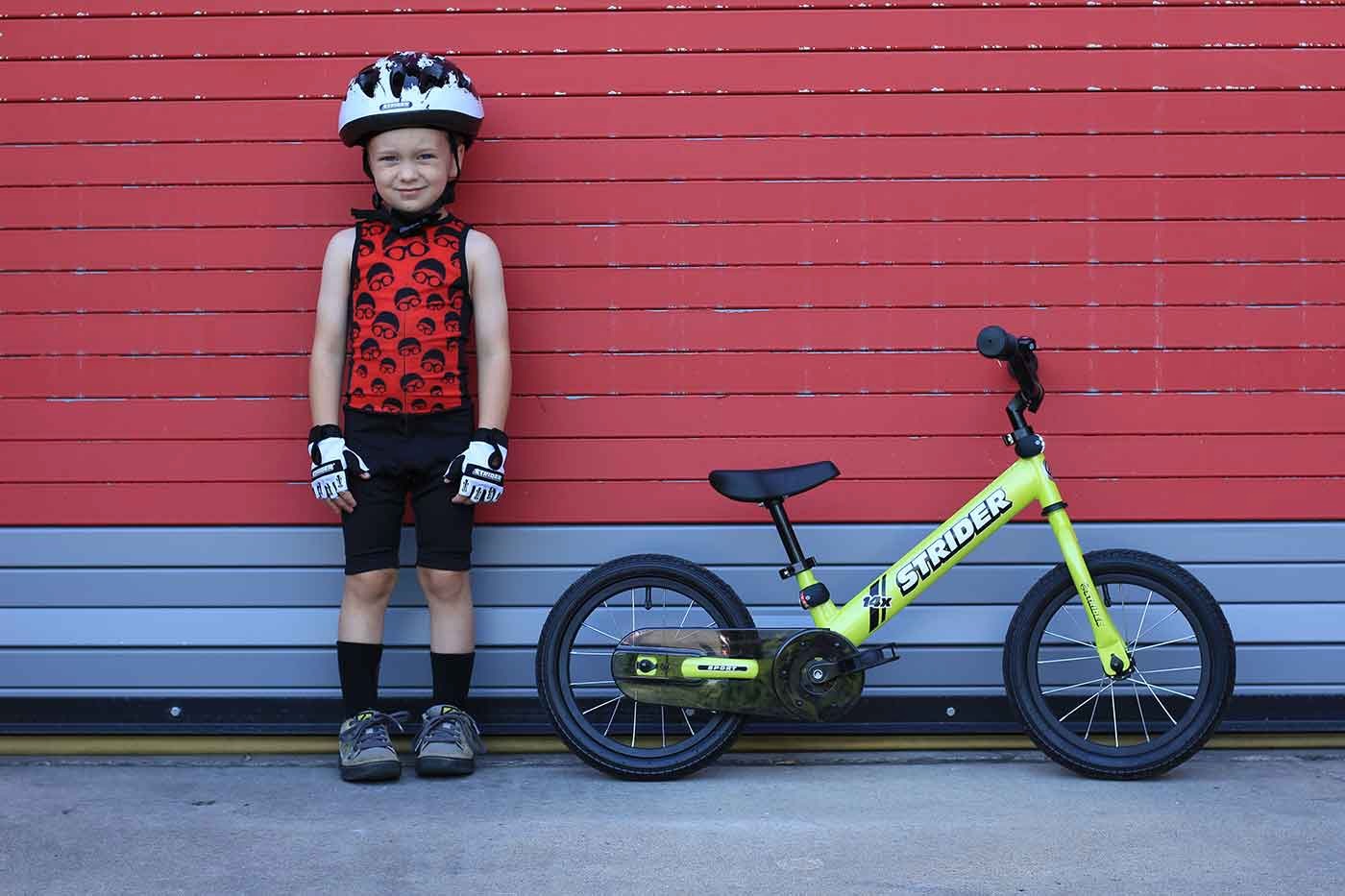
How We Tested the Best Balance Bikes
Over the past four years, our team of little testers and their parents have tested more than a dozen different balance bikes. Our testers included 10 different children aged 12 months to 5 years. We let the children use all of the bikes at different times and observed which balance bikes were easier to use and had any standout features.
We also interviewed the children to find out about their favorite models. It was fun to get in the mind of a child and learn some important factors we never considered (like color!). The Woom Original 1 was a consistent favorite due to its lightweight design and the included hand brake. Even small children who didn’t actually need a brake were excited to have one regardless.
The guide was initially written by frequent GearJunkie contributor Chelsey Magness. Chelsey is a mother of two, an avid outdoorswoman, and a professional adventure racer. As someone who loves to ride bikes, she introduced her children to life on two wheels at a young age with the help of balance bikes. Chelsey and her two kids tested the majority of the models on this list.
Our latest update of this Buyer’s Guide was led by all-around outdoorsman and proud parent of a 2-year-old daughter, Nick Bruckbauer. Nick is a year-round Lake Tahoe resident and enjoys hiking, biking, and splashing around the Tahoe area with his family.
For your active little ones, our GearJunkie parents and kiddos have also tested the Best Kid’s Snow Gear and the Best Kids’ Fitness Trackers.
Buyers Guide: How to Choose the Best Balance Bike
What Is a Balance Bike?
Balance bikes are designed to provide toddlers with a way to develop balance and comfort on a bike before their feet ever leave the ground. With the pedals removed, kids go back to the age of the Flintstones and are fully foot-powered. This gives them far more control and a slow introduction to the use of muscles they may not have been using before.
Using a balance bike to learn how to ride allows for a gradual and close-to-the-ground method of learning to ride. If a toddler wants to get on the local mountain bike trails, starting here will be best for their future confidence.
Even for what seems to be a simple beginner’s toy for toddlers, there’s still a lot that goes into picking the right one.
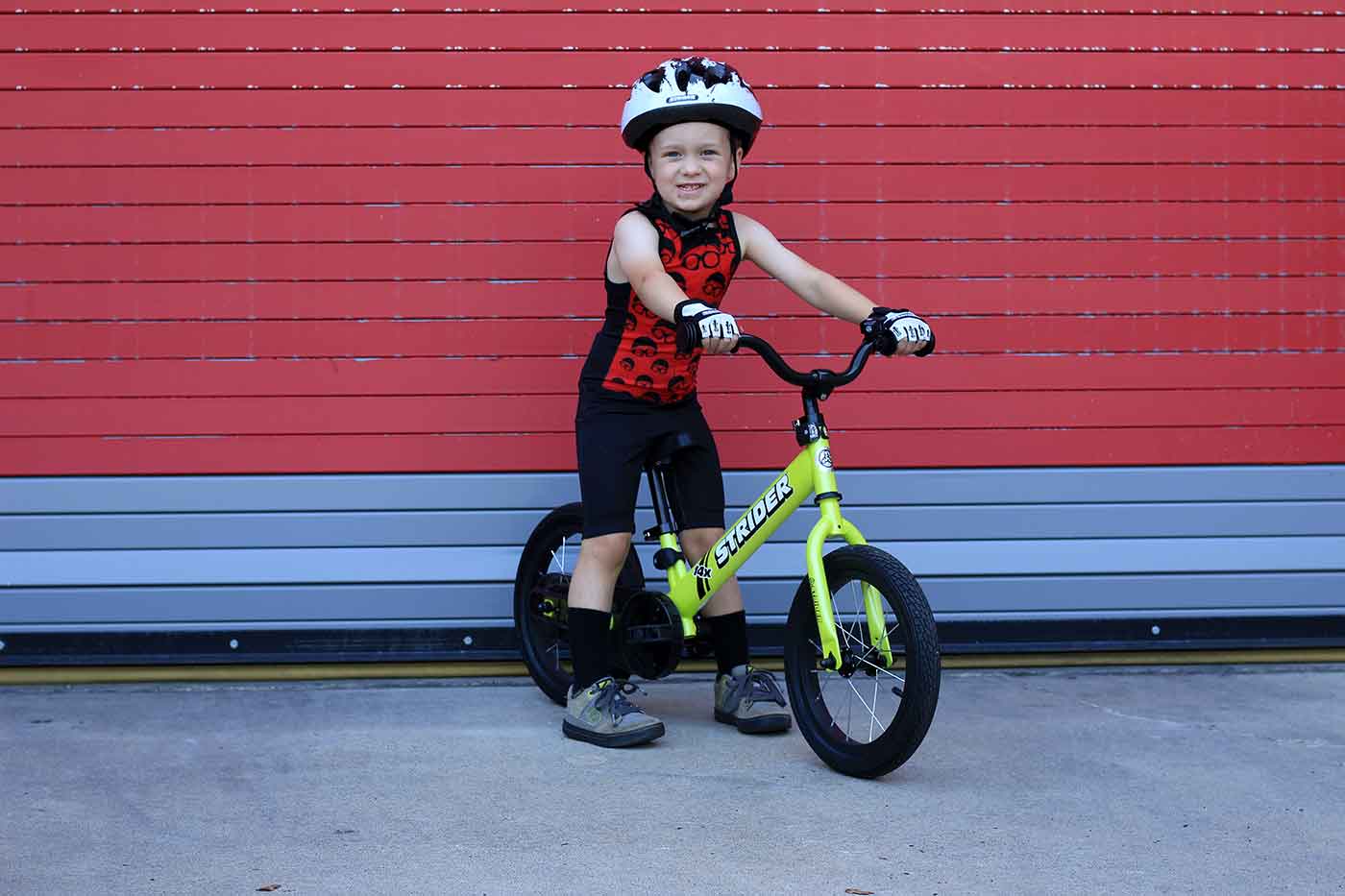
Age Range
One of the best places to start is looking straight at the age range. This will quickly tell you if your toddler is even in the running for a particular bike. The age range for balance bikes happens to align with one of the time periods when kids are growing the fastest and need a new pair of pants every other day.
Looking at the age range will narrow the playing field quickly and easily. For example, the Strider 14X Sport will be a great fit even for 5-year-olds in higher percentiles for size, while The Croco Balance Bike might not be.
There aren’t many huge differences in the age ranges, as most of the balance bikes on this list are adjustable. There are a few exceptions, like the Retrospec Cricket. This four-wheeler is made for tiny tots under 24 months, and that may be pushing it.
All kids are different, and there can be major size differences between two kids born on the same day, so there are a few more aspects to consider.
One of our favorite models for growing toddlers is the Yvolution Velo Flippa 4-in-1. This versatile bike is ideal for timid riders who want to start small, but may progress very quickly. It includes a removable handle that lets parents push and steer the bike and lets the child simply ride along. Once they gain more confidence, there are several other configurations to suit their current abilities.
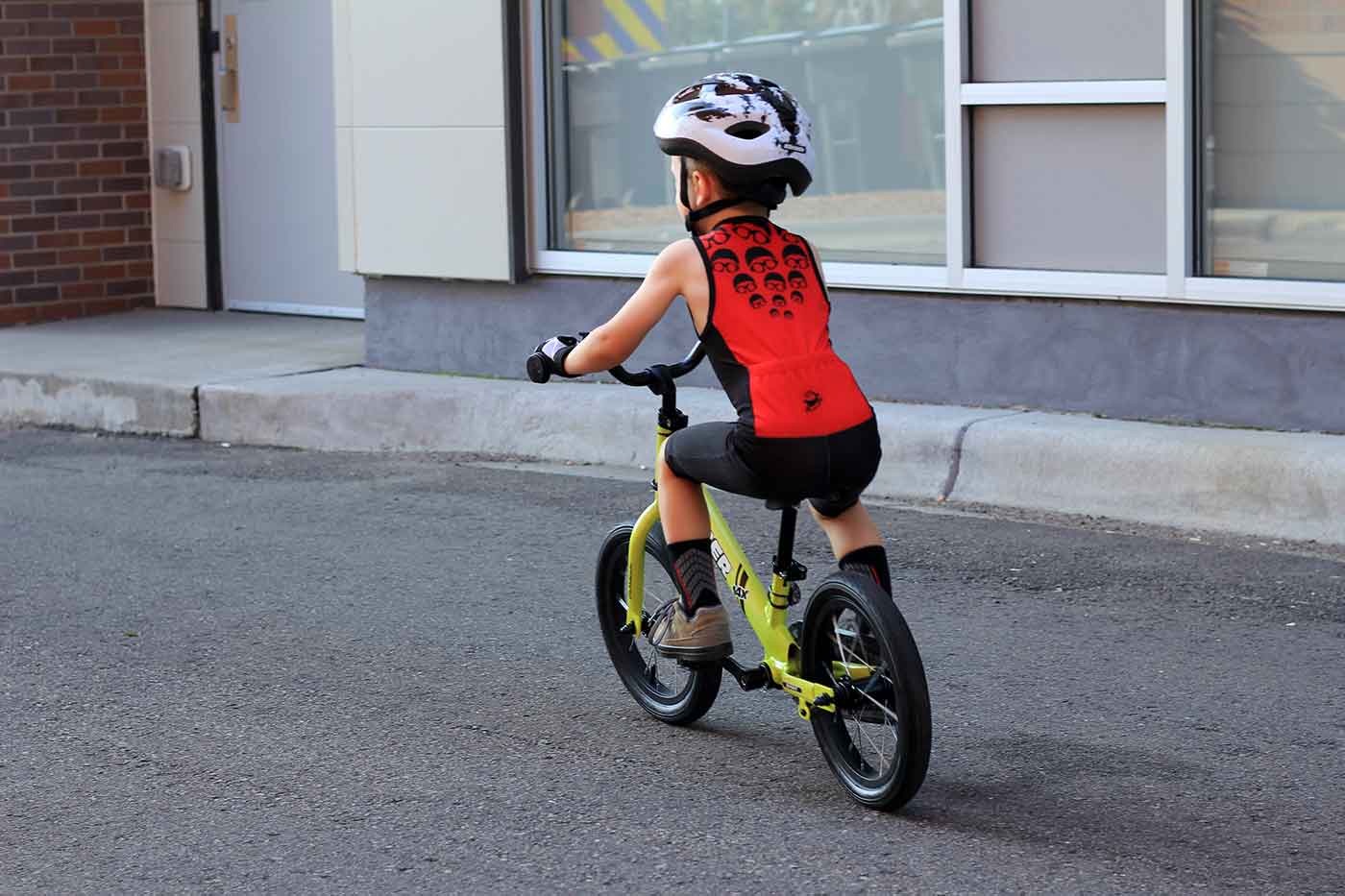
Seat Height
The seat height will be one of the best indicators for fit on a balance bike. Unlike with age range, you can easily measure this before making a purchase and make a more informed decision.
A balance bike with a wide range in seat height will be the most likely to grow along with your kid. In general, you’re looking at starting at 10 inches to about a 19-inch maximum height.
It’s essential to keep in mind that seat height isn’t the only aspect of the bike that will influence how comfortable your toddler feels on it. The bike’s geometry needs to be built to keep a kid upright or very slightly leaning forward. A short distance between the handlebars and seat post will result in a rider that looks like they’re trying to get into the fetal position.
The most accurate way to figure out if a bike will fit your child is to pull out the measuring tape. Most bike manufacturers will recommend a bike based on inseam measurements. It’s an easy measurement to take quickly or even find on the label of a pair of pants. This will give you the best information to determine whether a bike will fit properly.
Size Adjustability
While it’s nearly impossible to adjust the length between the handlebars and the seat, some bikes manage to make adjustments in other ways. The frame of the Wishbone 3-in-1 can be flipped upside down to shift the step-in height. This can dramatically change the bike’s fit and access for younger ages.
Another place to look for size adjustability is in the handlebars. Most balance bikes are equipped with a steerer tube that can shift the height of the handlebars.
The more you raise the seat height and keep the handlebars the same, the further forward you’ll start to hunch. This can lead to knees knocking into the handlebars, unstable positioning, and a general hatred of riding.
For kids, comfort is one of the best ways to trick them into liking something. If your toddler isn’t comfy on the bike they’re learning on, they may not want to keep trying.
Larger balance bikes are a good choice if your kid is above the average height but aren’t typically necessary. The largest bike on our list, the Strider 14X Sport, has a 14-inch wheel size, which can be a bit too much for younger kids to handle.
We’d recommend starting with the smaller bikes and then adjusting them to their max. Then you can move on to one of the larger balance bikes that can be fitted with pedals when your child is ready.
Step-In Height
The final aspect of sizing is the step-in or stand-over height. A low step-in height allows younger and shorter kids to stand on the bike comfortably. They should never be sitting on the bike’s main tube.
No matter the age or size of your child, they should be able to stand with their feet flat on the ground when straddling the bike’s main tube. This will let them slowly move toward bringing their legs up off the ground and feeling more comfortable with the bike in general, even if that means just walking with their hands on the handlebars.
A 12-inch balance bike (like the Strider 12 Sport) has a step-in height of about 7 to 8 inches. That’s an excellent fit for the average 2-year-old.
Not only does a lower step-in height help access, but it also lowers the center of gravity. The lower the center of gravity, the more stable the rider.

Weight and Frame Material
We’ve hit on the fact that parents can get stuck carrying gear for their kids all the time. Maybe you’re into getting the extra workout, but it’s probably more likely that you don’t want to haul a 30-pound block of steel around unnecessarily.
Thankfully, bike technology dramatically improved with time, even in balance bikes for toddlers. Steel is still the most common material, but aluminum bikes are becoming more commonplace and tend to be a cheaper option.
In general, you don’t want the bike to weigh any more than a third of your child’s body weight. The kid-to-bike ratio helps determine one of the most important parts of riding a bike: being able to stop. A heavier bike will naturally move faster and take more force to slow down.
If you’re going for a bike without a break and are incredibly worried about the stopping capacity of your child’s legs, an aluminum frame will help take a lot of tension off your anxiety-riddled brain.
A bike like The Croco is a fantastic ultralight option. In addition to the aluminum frame, it has foam tires that weigh a third of what normal tires can weigh.
Tires and Wheels
We’re seeing more and more improvement in the tires and wheels of balance bikes these days. Certain bikes, like The Croco, have sealed wheel bearings and EVA foam tires that prevent wobble.
Foam tires are naturally less durable but require little to no maintenance. They’re also designed to not leave marks all over your kitchen floor while your toddler races around your feet before dinner.
While the wheels of a balance bike are getting less punishment than those of a downhill mountain bike, they’re still important to any kid’s safety and enjoyment. A poorly made set of wheels will have ball bearings that rust out quickly and seize up on the rider.
The biggest factor to look at with wheels is size. A 12-inch wheel will suffice for most riders until they’re about 6 years old. For toddlers that are a bit bigger, a 14-inch wheel, like that on the Strider 14X Sport, will help provide the right balance.
If you find a bike with wheels smaller than 12 inches, it’s best to stay away. Smaller wheel sizes can result in more wobble than the gyroscopic balancing force that the kids are learning to balance.
Brakes
While most kids will be OK stopping with their feet, brakes can be a good choice for those who tend to push the limits or live in hillier neighborhoods.
Hand brakes are the most popular system found on any current style of bike. The best brake system that you’ll find is a linear-pull hand brake, commonly called a V-brake (copyrighted by Shimano), triggered with your hands on the handlebars. Having the brake system hooked up to the rear wheel is best for learning and safety.
The brakes should be set to fully stop when you pull the lever with a single finger. Otherwise, it may be too difficult to engage for a youngster.
Strider offers a foot-actuated brake that can be added to almost any of their bikes, which is an excellent option for additional safety. It also helps teach about using coaster brakes, which are common on pedal bikes everywhere.
It can be best to start without brakes unless the balance bike comes with a hand brake installed. Starting without brakes will encourage slow movement and let the toddler learn how to control the bike rather than simply stopping it.

Easy Assembly and Maintenance
Fixing a bike can mean spending more time on YouTube than having fun with your little one. With so many moving parts, bikes can be complicated machines to fix on your own. Luckily, balance bikes have significantly fewer pieces to put together and fix on the go.
Due to shipping sizes, many balance bikes will need some simple assembly upon arrival at your house. The best balance bikes come along with an easy-to-understand instruction manual. Remember, you didn’t buy this bike at IKEA, so it should take less than half an hour to get rolling.
Woom and Strider include simple instructions to put the bike together once you get it. Just about any bike that doesn’t require any tools will only need to be puzzle-pieced together and sent on its way. In an ideal world, you won’t need to do a single thing. Just get the bike and go.
Thanks to a relatively low number of moving parts, there’s not too much to maintain on balance bikes. You can often find great bikes that don’t even require pumping up the tires. Most maintenance should be checking tires, adjusting height, and ensuring that your child hasn’t outgrown the bike.
Accessories
There’s a lot to be added to a balance bike to make it safer or just make it unique. Many of the bikes on our list offer customizable stickers and encourage creative design. This is fantastic for young kids to give them a sense of ownership over the bike and make them even more invested in hopping on and riding.
The Kinderfeet Wooden Balance Bike comes along with a chalkboard finish that will let your kid’s creativity shine through and be adjusted whenever they want.
Aside from creativity, plenty of accessories can be added for safety. A shrill bell attached to the handlebars is a great way to keep track of your kid and teach them to alert others of their presence on the sidewalks. Reflective tape for bike frames and tires is another safety measure to help expand the hours that your kids can ride their bikes.
Strider offers both the foot-actuated brake and the rocking base that can be used with some of their models. The rocker helps introduce a youngster to the bike above a carpeted floor rather than the pavement.
Many bikes also offer footrests that are typically built-in but sometimes need to be added. A pedal-free bike can often be fun to ride with your legs in the air, but something to rest your feet flat on will help further encourage comfort with balancing a bike.
Price & Value
Balance bikes are one of the simplest forms of the bicycle. Not only are they small, but without drivetrain components, pedals, and, in some cases, brakes, there isn’t much to them. Additionally, kids are small and light weight, so the bikes don’t require much from a design and engineering standpoint to make them functional. So, it’s not too surprising that they are relatively affordable, which is nice considering they will outgrow any of them in short order. The models we’ve included in this guide range in price from $50 up to $250.
Budget
The least expensive balance bike we tested is the Retrospec Cricket ($50). This compact little ride is made for kids between 1 and 2 years of age and is a great option for when they’re just starting out. It’s nothing fancy, but it’ll help the youngest kids get their feet under them. The Chillafish Charlie ($50 to $60) is another super affordable option to get kids rolling. Again, this bike is a wildly simple option for smaller kids, but you have the option to upgrade to entertaining glowing wheels for an extra $10.
Mid-Tier
If you’re willing to step up to the $100 mark or just above, you’ll get bikes that are a bit higher quality or have greater adjustability. The Yvolution Velo Flippa 4-in-1 ($96) isn’t the highest quality bike around, but it can used in four different configurations depending on your child’s needs. It can be a pedal trike, a balance bike, or it can be used as either of those with a push handle for parents to assist as they learn.
The Strider 12 Sport ($130) is quite similar to the more affordable Chillafish mentioned above, but the increase in price gets you a much sturdier bike that’s built to handle the rough treatment that it’s likely to get. Sometimes you get what you pay for, and in this case that’s a higher-quality frame and everything else that’s attached to it.
Premium
Believe it or not, you can spend as much as $1,000 on a balance bike. You read that correctly. The Specialized Hotwalk Carbon is a carbon-framed balance bike that even comes with carbon fiber wheels. Unless you have more money that you know what to do with, no one needs to spend that much.
Beyond that one truly unnecessary outlier, we consider anything over the $200 mark to be at the high end of the balance bike market. These are often balance bikes that are suitable for larger kids, made from higher quality materials and components, come with brakes, or have special features to convert them as needs change and skills improve. The Woom Original 1 ($249) is a great example. This bike is well made, lightweight, has a rear brake, inflatable tires, and a wide seat height adjustment range, which means you can probably get a couple of years of use out of it.
Similarly, the Strider 14x Sport ($220) has a convertible design that can carry your little one from striding to pedaling over time. As your child progresses, this bike can be adapted along with them with the addition of the pedal conversion kit ($70). You’ll pay a little extra for it, but it’s still less expensive than buying a separate pedal bike that they’ll quickly outgrow. Another adaptable option is the Wishbone Original 3-in-1 ($230), which commands a high price for its sustainable materials and 3-in-1 design. As your child grows, you can go from a trike to a 2-wheeler and potentially use the same bike between 1 and 5 years old.
Frequently Asked Questions
There’s no “best age” for a kid to start riding a balance bike. Some kids are ready at one year, while some might be ready at 2 or 3. Development is tricky, and only the parents genuinely know when their child is ready for jumping on a bike.
For the sake of giving an age, 18 months is the approximate sweet spot for starting to ride a balance bike. Anywhere after 18 months up until 3 years will be prime time to begin on the bike. After 3 years, you may want to look at buying a 14-inch bike, but the Strider 14X can accommodate that.
We’ve picked the Woom Original 1 as the best balance bike of the year. It’s got everything you could want regarding safety features and doesn’t cost a fortune. It’s potentially the best bike for beginner riders up until they’re just over 3 years old.

Riding a bike is all about learning how to maintain balance with forward motion. This requires muscle development that training wheels don’t allow for. Balance bikes help develop those muscles and gain the confidence needed for a pedal bike.
Balance bikes aren’t for everyone, but they are an excellent fit for most athletically trending kids. Some kids naturally prefer a scooter or a four-wheeler, so it’s not always guaranteed that your child will take to a balance bike.
If your kid latches onto a balance bike, it is guaranteed to be the most direct route to learning how to ride a pedal bike. The balance bike makes the most difficult part of riding a bike familiar, so when the time comes to add pedals, they’ll tackle it with confidence.
As of today, balance bikes are the new training bikes. They’re the new step toward learning how to pedal a bike and bombing down singletrack lines. Even if technical riding is far from the goal, balance bikes are widely regarded as being the best way to learn to ride and be fun to ride on their own.
Balance bikes are so much closer to the experience of riding a bike that they’re better than any other option to learn how to ride. The balance bike allows kids to become comfortable balancing on a moving bike and introduces braking and pedaling.
Pedaling a bike is surprisingly one of the most natural parts of riding a bike. With the addition of pedals, moving your legs to go forward makes sense. Balancing upright is where the newest skills come into play, and that’s precisely what balance bikes help provide.
This slow movement through the process allows you to skip training wheels altogether. It’s the experts’ new favorite way of getting kids to learn how to ride.
Every brand will find a way to tell you that their bike is the best one for you and your toddler. If we listened to advertisements across the internet, we’d all be broke and surrounded by broken gear. It’s unwise to dive into purchasing anything without the proper research, which is likely why you’re here.
The main things you’ll want to check are seat height and other points of adjustability, the recommended age range, and the materials used to make the bike. Of course, a lot of us will look first at the price. Try your best to pull your eyes away from the price and instead look a bit further down the page.
While price can tell you something about the bike, it doesn’t give the full information. We also understand the desire to not spend too much on something that your kid will outgrow.
Look at the specifications first. If price is your biggest factor in choosing the bike, check out the best budget bike (Chillafish Charlie) first. Just remember that the cheaper the bike, the less likely it is to last as your family grows.
If you pick the right balance bike, you can see it ridden through generations of kids to come. Good balance bikes are built to last. So, while your child may outgrow the bike by 6 or 7 years old, the bike will be ready for your next toddler to use (if that’s in the picture).
We know how much kids love to leave things in the front yard, but some of the bikes on this list won’t last nearly as long if left out to the elements. The tires on the Kinderfeets Wooden Balance Bike are fully decomposable, after all. Your bike likely won’t sit in the front yard long enough to deteriorate in front of your eyes, but it’s best to keep it in a cool, dry place.
Along with sustainable materials decomposing, steel frames will rust at the first sign of oxygen when the paint chips off. Kids also aren’t well-known for treating their gear gently, so you can expect chipped paint.
A balance bike is meant to be used for years. It slowly develops the different muscles and confidence needed for a pedal bike, so they’re built to last that long.
However, part of the gear lasting years is proper upkeep and maintenance. So, following the manufacturer’s guidelines for maintenance and storage will increase the lifespan of the bike.
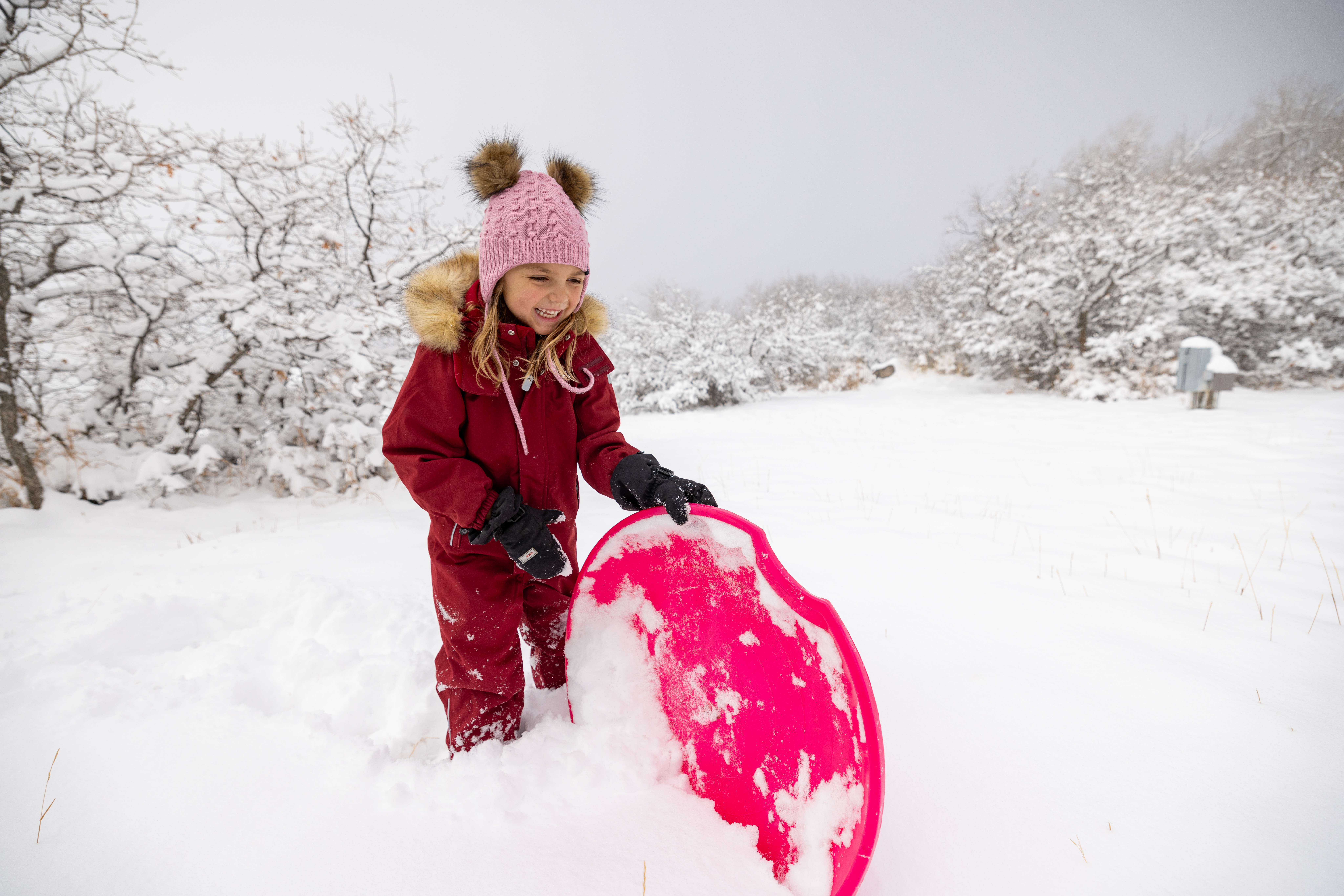
The Best Kids’ Snow Gear of 2025-2026
We put the best kids’ snow gear and cold weather clothing to the test. Our top picks include Patagonia, Columbia, and more.
The Best Kids’ Fitness Trackers of 2025
There is a select market of fitness trackers designed specifically to help kids get active in a fun and exciting way. Check out our list of the best ones!




